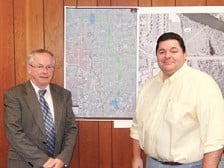Relieving roads, directing development

Polk County officials have moved a step closer to building a freeway around the northeast side of Des Moines.
Engineers have identified a preferred route in the Northeast Beltway Corridor Study to the northeast of the Interstate 35/80 interchange, which they discussed at a public meeting in Bondurant in late January. The route would essentially be a continuation of U.S. Highway 65 north of Interstate 80. It would curve west and intersect with Interstate 35 north of Northeast 126th Avenue in Elkhart and end at U.S. Highway 69.
The two main purposes of the roadway would be to relieve congestion on the existing interstates and promote growth in the corridor between where the new roadway will be constructed and Interstate 35 north of I-80.
“I think it is consistent with this whole notion of balanced growth within the metro area,” said Jerry Searle, an engineer with Snyder & Associates Inc., who is in charge of the study. “It’s an investment in public infrastructure that will encourage the distribution of jobs, population and housing throughout the metro area.”
The preferred route is one of 17 that the study looked at, and was determined to be the one that best fit the purpose of the project without displacing a large number of people. Kurt Bailey, county engineer with the Polk County Public Works Department, said the proposed route would force the county to move six homes and 12 farms, but that number could go down by fine-tuning the exact location of the road. The county would have to pay homeowners and farmers to relocate, per federal laws.
“This was the (route) that had the least impact to not only homes, but historical properties and wetlands,” Bailey said.
In segments
Though the idea of a northeast roadway has been in the Polk County Comprehensive Plan since 2005, the process from idea to highway is in its very early stages.
“It’s not just like this is going to start being built tomorrow,” Bailey said. He compared the process to that of completing Iowa Highway 5 and U.S. Highway 65. “It took 40 years to get it built and finally completed,” he said. “You might see similar time frames.”
Construction is projected to begin anywhere from 2015 to 2025, depending on funding. The cost of the entire project is estimated at $441 million. That estimate assumes a four-lane road for the entire length.
Getting there won’t happen all at once. Searle said the better course of action would be to build the road in segments, even starting with two lanes but leaving the opportunity to expand to four.
“And then you are really looking at 40 years of improvements within the corridor,” he said. “I think a lot of our infrastructure is built that way, when I look at all the projects. … To actually implement this project about two miles at a time, that would make a lot of sense.”
Between where the road would intersect with Interstates 35 and 80, there are four interchanges tentatively planned: at Northeast 62nd Avenue; at Northeast 78th Avenue; at Northeast 94th Avenue; and at Northeast 118th Avenue. Building the road from interchange to interchange would be the logical way to do it, Searle said.
The original feasibility study done five years ago looked at extending the road all the way to Iowa Highway 141, but the study determined it would make more sense to look at that segment as part of a separate project.
“This would really stand alone, even if (the other section) is never developed,” Bailey said. “It’s not dependent on other major improvements.”
Why we need it
The project is designed to fulfill two needs.
First, it gives a direction for economic development to accommodate expected growth in the area.
Searle pointed to a number of things that suggest growth is already occurring in the area, including Ankeny’s population growth, which skyrocketed by 68.1 percent from the 2000 census to the 2010 census. Beyond that, Altoona has seen a lot of development, including a Bass Pro Shop, and Bondurant has expressed plans for growth. A roadway in this area directs the growth in a logical way, Searle said.
“I think this also addresses some of those issues of urban sprawl that people have concerns with, because it’s going to direct development inward instead of outward,” he said.
The other project goal is to relieve traffic on the interstate system. The feasibility study outlined projected growth in vehicles on the existing roads would cause them to exceed their designed capacity in some corridors by 2020.
“It’s going to start causing significant delays on those roadways without major investment,” Bailey said. “So that’s why we kind of looked at this road as an alternative to delay those improvements.”
Community feedback
The communities that would be affected have bought in, or at least chipped in financially.
The cities of Alleman, Altoona, Ankeny, Bondurant, Des Moines, Elkhart and Polk City have formed the Beltway Coalition, and each contributed funding for the initial feasibility study. An environmental impact study is under way with a price tag of about $647,500, of which $510,000 will come from federally earmarked funds that the county received in 2005.
The county and Snyder & Associates held a public meeting on Jan. 20 to unveil the proposed route and take citizen feedback. Bailey said most people seemed to be in favor of the project, though he acknowledged that some were upset that the road could go through their properties.
“I don’t think you are going to please everybody when you start establishing new roads,” he said.
In determining the route, the study looked at a number of factors including potential relocations, environmental impact and keeping existing farms intact.
“We try to consider all of those things for each of the 17 alternatives, and this is the one that came out having the fewest impacts and, quite frankly, would best accommodate future development,” Searle said.
The goal right now is to get the information out, he said.
“Early on everyone’s saying, ‘Where’s it going?’ Now they know,” Searle said.










